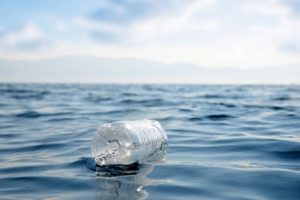What is Algae?
Algae are a diverse group of aquatic organisms that can conduct photosynthesis, and they are an essential part of marine and freshwater ecosystems. They have a role in the food chain by providing food for small fish and zooplankton, and the simplest form of algae provides benefits by oxygenating the water. Having good algae in the water helps use more carbon dioxide and releases more oxygen into the atmosphere.
Algae require nutrients, warmth, and sunlight to grow and reproduce. They are found in shallow surface water and the upper 200-300 feet of ocean water. Algae can be a good indicator of the health of the water. If there is an abundance of green algae, it indicates healthy water. However, a body of water with an abundance of blue-green algae indicates polluted water that may be toxic.
What is Blue-Green Algae?
Blue-green algae are bacterial microorganisms that have inhabited the earth for hundreds of years. One of the first known recordings was in South Australia in 1878. Blue-green algae are also known by their scientific name, cyanobacteria, and they share features in common with algae.
They are commonly called blue-green algae due to their bright blue-green color, but clusters may also appear as olive green, brown, tan, teal, lime green, and even red. Cyanobacteria or blue-green algae naturally occur in several varied environments, including ponds, rivers, wetlands, streams, shorelines, lakes, and even oceans. They are becoming a more common occurrence in North America and many other parts of the world, especially along shorelines.
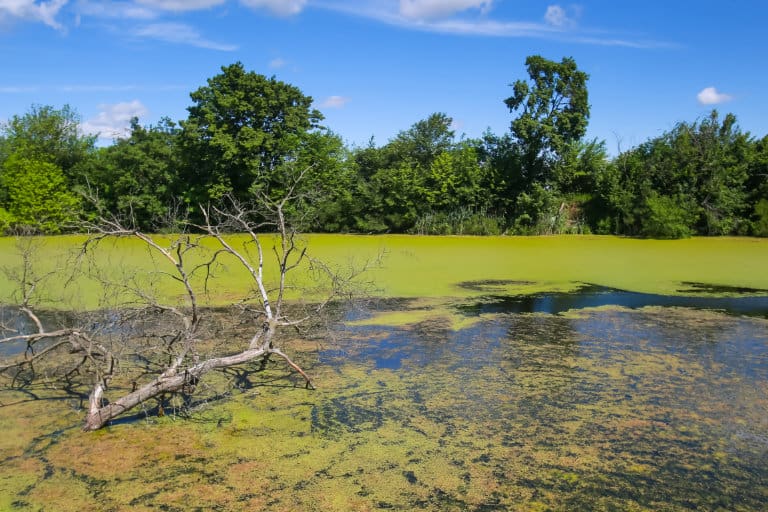
Although some species of algae are not harmful, it is important to note that certain species of blue-green algae are poisonous to humans, animals, and plant life. These microscopic blue-green algae can form visible fast-growing patches known as Harmful Algal Blooms or (HABs). Blue-green algae blooms are increasing in many parts of the world.
The most common time for the growth of algae blooms is during warmer weather in the summer and early fall, especially in warm, shallow, and slow-moving waters. Under normal conditions, algae may not be visible, but algae populations can quickly form a large mass or scum called a bloom during optimum conditions. In the right conditions, they can spread rapidly and cover an entire body of water. HABs can produce a strong odor; newer blooms may smell like freshly mowed grass, whereas old blooms may smell like musty rotting garbage.
Warm weather, along with certain nutrients such as phosphates from agricultural runoff, creates the perfect environment for the growth of large harmful blue-green algae blooms (HABs), which produce toxic concentrations of a chemical called cyanotoxin. Cyanotoxins are a group of chemicals formed by blue-green algae. Microcystin is the most common type and can be harmful to humans, animals, fish, livestock, and aquatic ecosystems. Blooms can last for days, weeks, months, or even all year, and they can even grow in icy winter conditions. HABs are also occurring across the globe.
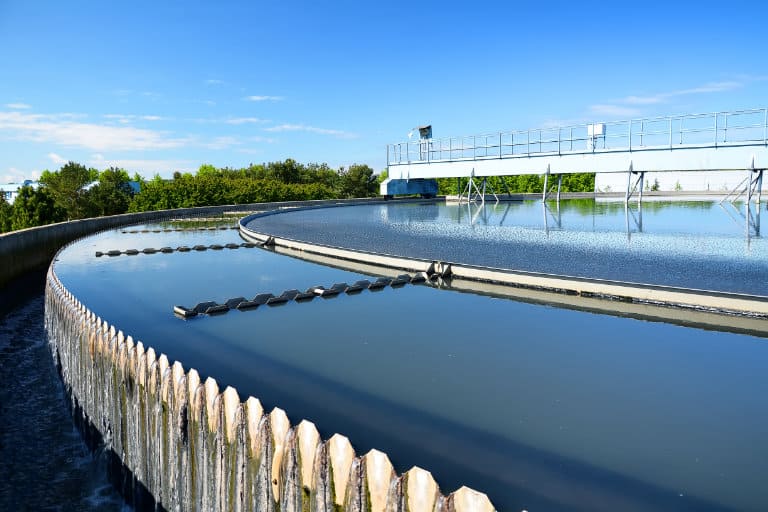
Municipal water treatment facilities are beginning to recognize the possible health threats of microcystin, and some areas perform routine testing and treatment. However, many places do not routinely test for or treat microcystins in their municipal drinking water quickly or effectively.
What are the harmful effects of Blue-Green algae or Microcystin?
Exposure to harmful concentrations of blue-green algae or Microcystin through swallowing, contact with skin, or inhaling airborne droplets via swimming, bathing, or showering, can cause a wide range of undesirable symptoms, including fever, headache, and vomiting. In more serious instances, microcystin can produce liver, kidney, and nervous system damage and can be fatal in very severe cases.

Symptoms that can occur from drinking water containing harmful blue-green algae or microcystin include; fever, nausea, headaches, sore throat, dizziness, stomach cramps, diarrhea, abdominal pain, vomiting, and mouth ulcers. There are reports of livestock and pet deaths from the ingestion of large amounts of blue-green algae.
Contact with water contaminated with blue-green algae toxins produces symptoms such as irritation of the eyes and ears, inflammation of the throat and respiratory tract, and skin rashes. If exposed to harmful blue-green algae, it is important to thoroughly rinse your body with fresh, clean water immediately after the exposure.
Water containing microcystin can be harmful to animals and should not be used for pets or livestock. Also, the contaminated water should not be used to water plants, especially those used as a food source.
It is crucial to note that toxic blue-green algae may be present in clear water, and not only where there are visible algae blooms. Always assume that a blue-green algae bloom may contain harmful cyanotoxins such as microcystin. Water testing is the only way to ensure the body of water growing or showing algae is safe to drink or use.

Local health departments or health units test for and report incidences of increased bacteria and blue-green algae levels. If beaches contain high levels of algae or bacteria, signs are posted to advise against swimming or bathing. Residents are alerted if drinking water is contaminated, urging them to get their drinking water from another source such as a Reverse Osmosis or Nanofiltration System, or costly store-bought bottled water.
Municipal water containing cyanobacteria such as microcystin should not be used for drinking, cooking, dishwashing, laundry, bathing, or showering. It is vital that residents do not boil the tap water; it does not remove the cyanotoxins! Boiling water with microcystin actually increases the toxin’s concentration!
It can be challenging for municipal water treatment plants to remove blue-green algae from drinking and household water, mainly when it contains harmful cyanobacteria such as microcystin. However, many water treatment facilities have turned to nanofiltration to assist in the safe removal of harmful contaminants from municipal water sources such as microcystins.
When blue-green algae produce cyanotoxins, they can exist in two forms. The first form is cell-bound, where the cells are healthy and stored internally. The second is the released form; toxins are released from the blue-green algae cells due to age, deterioration, or damage. Some water treatment options only remove cell-bound blue-green algae, while others only remove released toxins, and some may actually rupture the cells and release toxins.
Currently, there are no official internationally accepted regulatory limits in place for cyanobacterial toxins in drinking water. A provisional guideline has been established by the World Health Organization of 0.001mg/L for total microcystins in drinking water. The U.S. Environmental Protection Agency (EPA) official health advisory levels for North America were determined in cooperation with Health Canada. The acceptable limit of microcystin in municipal water for children under six years of age is 0.0003 mg/L, and for everyone else, the limit is 0.0016 mg/L.
Very few studies have been done worldwide to assess drinking water systems and their effectiveness in removing blue-green algae and microcystins. One such study is “Small Drinking Water Systems and Blue-Green Algae Toxins,” performed by the Walkerton Clean Water Center (an agency of the Government of Ontario, Canada). It compared the different small drinking water systems and how well they removed blue-green algae and cyanotoxins. It clearly showed that Nanofiltration and Reverse Osmosis were highly effective at removing 95% or more of the microcystin toxin and up to 99.9% of the blue-green algae cells.
What are Nanofiltration and Reverse Osmosis?
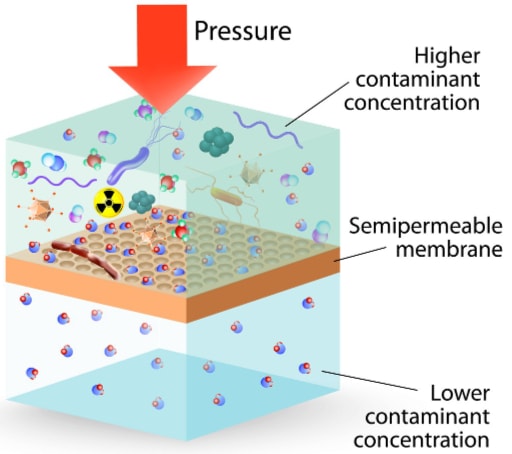
Nanofiltration and Reverse Osmosis are two of four membrane technologies that can be used to create clean, pure water. Energy is applied to force water through a semipermeable membrane, which rejects 95% – 99% of dissolved and suspended solids. The membrane allows the passage of water molecules while rejecting blue-green algae, including microcystin, chemicals, heavy metals, bacteria, and more.
The Thin Film Composite Filters (TFC) used in Nanofiltration are designed with a pore size ranging from 0.001-0.01 microns, while the pore size for Reverse Osmosis membranes is 0.0001-0.001 microns. These membranes can significantly reduce blue-green algae hardness levels, tannins, turbidity, nitrates, sulfates, total dissolved solids(TDS), color, and moderate salt levels from your water.
Since hard water minerals like magnesium and calcium are also removed in the nanofiltration and reverse osmosis processes, water that passes through these membranes is softened. Depending on the water hardness, a water softener may be used to protect the TFC membranes and give them longer life.
Nanofiltration membranes provide potent separation of inorganic salts and small organic molecules. These membranes remove up to 95% of contaminants and have made Nanofiltration a safe and effective choice in water and wastewater treatment. They also have niche applications in food engineering and the pharmaceutical and biotechnology industries.
Reverse osmosis also separates two solutions through a semipermeable membrane but uses applied pressure in reverse to force the contaminants to one side (the drain), leaving only clean, pure water on the other side of the membrane in the RO tank. Up to 99% of all contaminants are removed with reverse osmosis technology.
A Whole Home Reverse Osmosis System provides safe and highly efficient water purification for your home and may be customized for your household needs. Reverse osmosis is used to purify water for many industrial and commercial settings such as hospitals, hotels, agriculture, and the food and beverage industry.
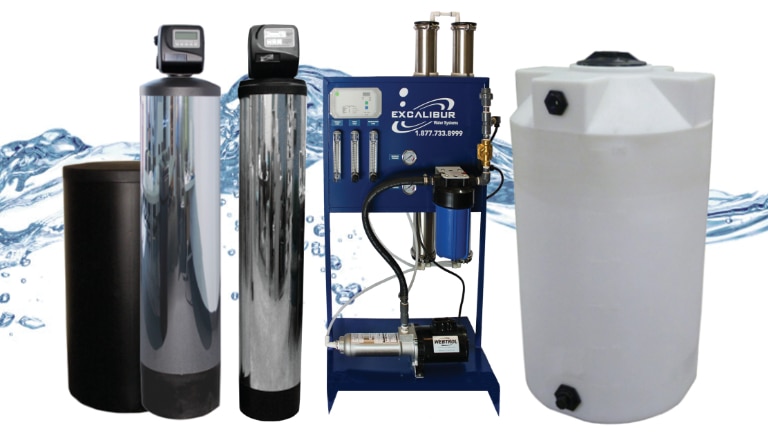
Nanofiltration and Reverse Osmosis are two of the most effective methods of purifying well or surface water sources such as lakes and rivers. Nanofiltration membranes operate at lower pressures and selectively reject solutes based on their size, unlike reverse osmosis membranes that reject all solutes.
Key characteristics that distinguish Nanofiltration from Reverse Osmosis membranes are; higher flux compared to reverse osmosis, low rejection of monovalent ions (Salts), and high rejection of divalent ions (Calcium and Magnesium).
The Nanofiltration and Reverse Osmosis Processes
The Excalibur Whole Home Nanofiltration and Reverse Osmosis Systems utilize reliable, high-performance membrane technology to provide the best water to your entire home. These systems remove a large majority of contaminants from your water by pushing the water through a semipermeable membrane.
When feed water enters the system, water molecules can pass through the small pores of the membrane, while chemicals, heavy metals, and other contaminants are rejected and sent to drain. The water that passes through the nanofiltration or reverse osmosis membrane is clean and pure, with 95%-99% of contaminants having been removed in the process.
Whole Home Nanofiltration and Reverse Osmosis Pre/Post Treatment:
Pre and post-filters are incorporated with these systems to protect the membrane(s) and provide the highest quality water throughout your household. Each system is customized to meet your family’s specific water needs to provide the best water for your home or business.
Pre-Treatment
Pre-treatment filtration is custom engineered to your specific application based on a water analysis, and additional filtration may be used as a pretreatment to protect the TFC (Thin Film Composite) high purity membrane, giving it a longer life.
Post-Filtration
A pH balancing neutralizing filter is used after the Nanofiltration or
Reverse Osmosis System.
Benefits To Your Home

A Whole Home Nanofiltration or Reverse Osmosis System not only offers you a variety of health benefits from the consumption of pure water, but it also provides benefits to your home.
With soft, pure water, the life of your water-using appliances will be extended, and plumbing issues due to mineral buildup in your pipes will be prevented. Hard water problems like mineral buildup on fixtures and appliances, cloudy glassware, and dull/stiff clothing are no longer a problem; 75% of wastewater is recycled, providing significant cost savings, up to 24% on energy costs.
Do Nanofiltration and Reverse Osmosis Systems Remove Harmful Blue-Green Algae?
Yes, the Whole Home Nanofiltration System removes 95% of contaminants such as blue-green algae and toxic microcystins, chemicals, heavy metals, and organics from your water supply. In comparison, the Whole Home Reverse Osmosis System eliminates up to 99% of sediment and contaminants, including blue-green algae, microcystins, bacteria, viruses, chemicals, pesticides, pharmaceuticals, and more.
Very short exposure to most contaminants in your water won’t cause acute health effects. Still, they can lead to chronic adverse effects like cancer, liver, kidney, and reproductive issues over time. With increased pollution of ground, well, and municipal water sources, it is vital to ensure you equip your home with safe, pure water.
Contaminants removed by Nanofiltration and Reverse Osmosis include:
- Blue-Green Algae
- Lead
- Fluoride
- Cadmium
- Sulfates
- Phosphate
- Bacteria
- Pharmaceuticals
- Sodium
- Barium
- Viruses
- Pesticides
- Mercury
- Chlorine
- Uranium
- Hydrocarbons
- Chromium
- Cyanide
- + many more
Benefits to Your Body with the Removal of Blue-Green Algae
According to the Environmental Working Group, both short and long-term exposure to microcystin can produce adverse health conditions. Some short-term exposure symptoms include; headache, sore throat, vomiting, nausea, stomach upset, dry cough, diarrhea, mouth-blistering, and even pneumonia. Long-term effects include tumor development, liver failure, decreased sperm count, and cancer.
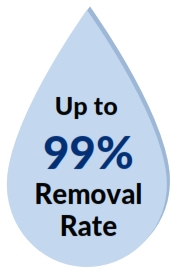
Using a Nanofiltration or Reverse Osmosis System is proven to reduce harmful microcystin by up to 95% and 99% of blue-green algae and many other dangerous contaminants; this dramatically reduces your exposure to these harmful bacteria and significantly decreases the development of illnesses and health issues by producing the purest and cleanest water used throughout your home.
Nanofiltration and Reverse Osmosis offer peace of mind that you are providing the safest water technology for your home and family.
Your water may look clean, but lake, well, and municipal water supplies may contain dangerous blue-green algae, plus other chemicals, bacteria, and heavy metals that pose a risk to your health.
Ensure the water in your home is free from dangerous impurities that can be found in your water supply with either a Whole Home Nanofiltration System or a Whole Home Reverse Osmosis System.
Enjoy the safety and benefits that come with drinking, bathing, and cooking with purified water, with a system that can be customized to suit your home and family’s needs.
For more information about Excalibur Whole Home Reverse Osmosis and Nanofiltration Systems, please contact us.


